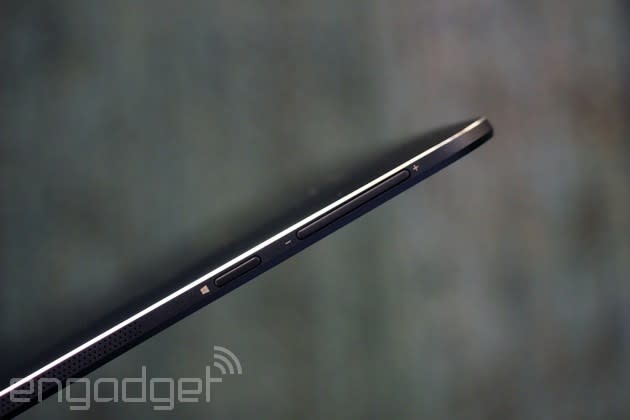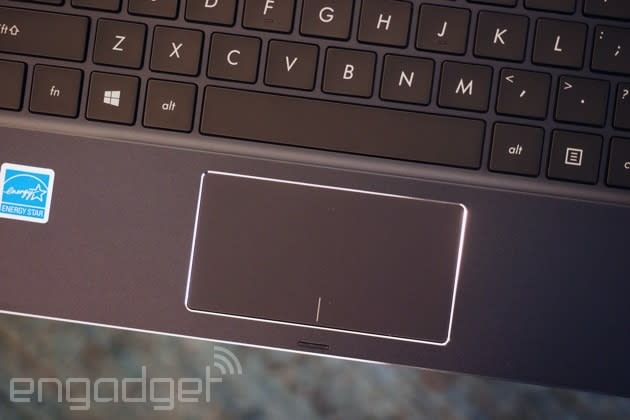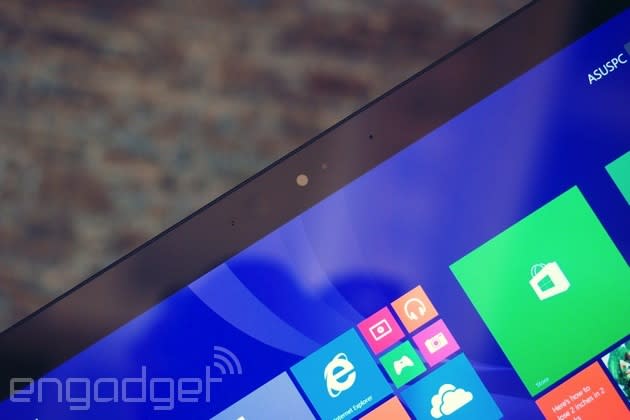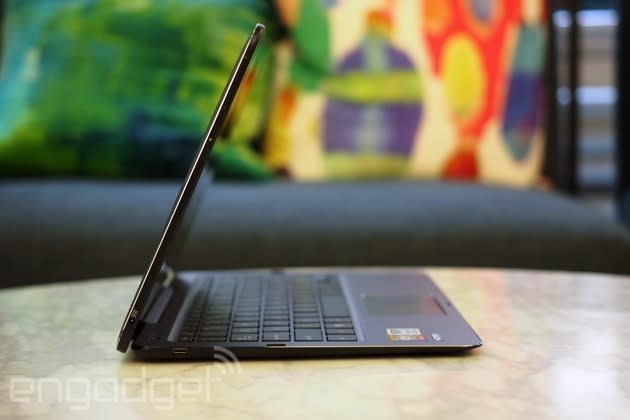ASUS Transformer Book T300 Chi review: thinner than air, but at what cost?

When ASUS formally unveiled the Transformer Book Chi T300, it did so in the cheekiest way possible: with a cleverly worded swipe at Apple. "Our Chi is thinner than Air," the company proclaimed -- a clear shot at the MacBook Air. ("Chi" means "air" in Mandarin Chinese, by the way, in case the dig wasn't obvious enough.) Indeed, ASUS' newest laptop/tablet hybrid measures a scant 0.3 inch for the tablet (or 0.65 inch when docked), making it slightly thinner than the Air, which comes in at 0.68 inch at its thickest point. The Chi is also more affordable than the Air (not to mention most other thin-and-light laptops), with a starting price of $699. On paper, it's a relatively affordable way to get your hands on a super-skinny machine. In practice, though, you're probably better off spending a little more on something else. Here's why.
Hardware

Problem number one: While the 12.5-inch Chi is indeed super thin, it isn't what I'd call super light. At 1.59 pounds for the tablet alone and 3.15 pounds with the keyboard dock attached, it's relatively heavy. Certainly, it feels noticeably heavier than the 2.62-pound Lenovo Yoga 3 Pro, which can also be used as a tablet when needed. The Dell XPS 13 is lighter too, at 2.6 pounds, though with its fixed display, you admittedly can't use it as anything other than a touchscreen notebook. Even the 13-inch MacBook Air, the machine ASUS seems to be gunning after, comes in at a lighter 2.96 pounds. All of which is to say: For a device that's being marketed for its portability, the Chi doesn't feel exceptionally light.
That alone isn't necessarily a dealbreaker, but in the case of the Chi, a big portion of those three-plus pounds feels like dead weight. As heavy as the Bluetooth keyboard dock is, it doesn't add much beyond the actual keys. There's no extra battery inside. And there are virtually no extra ports, save for a micro-USB opening on the dock's left edge. By comparison, the Yoga 3 Pro and Dell XPS 13 both offer two full-sized USB 3.0 ports and either a Mini DisplayPort or micro-HDMI connection. Even the 1.76-pound Surface Pro 3 manages to squeeze in a Mini DisplayPort and USB socket. Admittedly, Microsoft's keyboard cover offers nothing in the way of extra connections, but then again, it also barely adds to the tablet's weight or thickness. In any case, this is where I return to the weight issue: What's the point of having a machine this heavy if you're going to get fewer ports than you would on a lighter system?

This means that the dock is left with just one job: to offer a comfortable typing experience. Even then, I'm not a huge fan. It's mostly the touchpad; it's the worst I've seen on any recent Windows laptop. The tracking was so unreliable, so imprecise, that after a while I avoided using the trackpad at all; if it was possible to hit a button on the desktop with my finger, I did so using the touchscreen. On the bright side, I appreciate the generous 1.5mm of key travel; between that and the well-spaced layout, I was generally able to type without making mistakes.
All told, this means the Chi is, in some ways, at its best in tablet mode. Even then, its nearly 13-inch screen makes it a bit unwieldy. (On the bright side, this is the world's thinnest 13-inch tablet, for what that's worth, and at 1.59 pounds it's markedly lighter than the Surface Pro 3.) Even so, I find the SP3 easier to use as a slate, in part because of the less-stretched-out 3:2 aspect ratio. I don't necessarily think the Surface has a more comfortable keyboard or trackpad, but it does work better than the Chi as a tablet -- kind of an important thing on a hybrid device like this. And again, I can forgive the Surface's relatively middling keyboard cover somewhat because it at least doesn't weigh down the rest of the machine.

In the plus column, the Chi's all-aluminum casing feels solid, even if the full package is on the heavy side. I also like how the 12.5-inch screen has the tiniest of bumpers lining the edges; for all intents and purposes, it looks like edge-to-edge glass. Speaking of the sort, though the Chi is available at the lower end with a 1,920 x 1,080 display, I tested it with a higher-end, 2,560 x 1,440 panel, with a pixel density of 235 ppi. Particularly at $899 -- what my particular configuration costs in the real world -- this is a great screen: vibrant and crisp, with wide viewing angles, thanks to the IPS panel. In addition, there's an active digitizer inside, allowing it to recognize 256 levels of pressure sensitivity, whether through pen or finger input. That puts it on par with the Surface Pro 3, with one difference: The stylus pen here is sold separately, for $40. Unfortunately, I didn't get to test it out as part of my review, so I can't vouch for pen performance, except to say that having a pressure-sensitive screen at this price is already a plus.
Compared to the screen (perhaps the Chi's best feature), the sound quality feels a little like an afterthought, although it's still acceptable. The audio is a bit tinny, as is the case on many ultraportable laptops, but the volume is loud enough and I ultimately got used to the sound quality, even if it is a bit lacking in the bass department.
Performance and battery life
PCMark7 | 3DMark06 | 3DMark11 | ATTO (top disk speeds) | |
|---|---|---|---|---|
ASUS Transformer Book T300 Chi (1.2GHz Intel M-5Y71, Intel HD 5300) | 4,494 | 5,236 | E,1362 / P737 / X214 | 487 MB/s (reads); 366 MB/s (writes) |
HP Spectre x360 (2015, 2.2GHz Intel Core i5-5200U, Intel HD 5500) | 4,965 | 8,810 | E1,667 / P932 / X265 | 555 MB/s (reads); 270 MB/s (writes) |
Dell XPS 13 (2015, 2.2GHz Intel Core i5-5200U, Intel HD 5500) | 4,900 | 7,433 | E2,114 / P1,199 / X330 | 515 MB/s (reads); 455 MB/s (writes) |
Lenovo Yoga 3 Pro (1.1GHz Intel M-5Y70, Intel HD 5300) | 4,699 | 4,734 | E1,076 / P595 / X175 | 554 MB/s (reads); 261 MB/s (writes) |
Samsung ATIV Book 9 2014 Edition (1.6GHz Core i5-4200U, Intel HD 4400) | 4,835 | 5,947 | E1,752 / P948 / X297 | 551 MB/s (reads); 141 MB/s (writes) |
Microsoft Surface Pro 3 (1.9GHz Core i5-4300U, Intel HD 4400) | 5,024 | 5,053 | E1,313 / P984 | 555 MB/s (reads); 252 MB/s (writes) |
Samsung ATIV Book 9 Plus (1.6GHz Core i5-4200U, Intel HD 4400) | 4,973 | 5,611 | E1,675 / P867 / X277 | 547 MB/s (reads); 508 MB/s (writes) |
Acer Aspire S7-392 (1.6GHz Intel Core i5-4200U, Intel HD 4400) | 5,108 | 5,158 | E1,724 / P952 / X298 | 975 MB/s (reads); 1.1 GB/s (writes) |
I haven't mentioned this yet, but one of the main reasons ASUS was able to build a tablet this thin in the first place is that it makes use of a low-power Intel Core M processor -- the same sort of chip used in other fanless machines like the Lenovo Yoga 3 Pro and the new 12-inch MacBook. As we've already seen, the dual-core 1.2GHz Core M 5Y71 CPU here isn't quite as powerful as one of Intel's new fifth-generation Core-series chips, but it's predictably a bit faster than the 1.1GHz Core M processor used inside some competing machines, like the Yoga 3 Pro we reviewed. With 8GB of RAM, it roundly beat the Yoga 3 Pro in every graphics test we ran, though it fell slightly short in PCMark, a more general performance test. Startup takes a brisk eight seconds, just a hair faster than the Yoga 3 Pro. The SanDisk SSD inside also delivered respectable read speeds of up to 487 MB/s, with better-than-average write speeds of 366 megabytes per second. (Many SSDs top out in the two-hundred-and-something range when it comes to write rates.)
As for WiFi, the Chi has an 802.11n wireless radio (at least on models sold in the US), meaning it's not making use of the current-gen 802.11ac standard like the Yoga 3 Pro and other competitors. That said, I enjoyed a fast, reliable connection and had no problem streaming video and music from inside my apartment.
Battery life | |
|---|---|
ASUS Transformer Book T300 Chi | 5:51 (Quad HD)/6:14 (Full HD) |
MacBook Air (13-inch, 2013) | 12:51 |
HP Spectre x360 | 11:34 |
Apple MacBook Pro with Retina display (13-inch, 2015) | 11:23 |
Apple MacBook Pro with Retina display (13-inch, late 2013) | 11:18 |
Chromebook Pixel (2015) | 10:01 |
Samsung ATIV Book 9 Plus | 8:44 |
Apple MacBook (2015) | 7:47 |
Dell XPS 13 (2015) | 7:36 |
Lenovo Yoga 3 Pro | 7:36 |
Acer Aspire S7-392 | 7:33 |
Microsoft Surface Pro 3 | 7:08 |
As I've found on other Core M-powered laptops, including the new MacBook, the downside to having a quiet, fanless system seems to be that these machines tend to run warm. Even when I was just streaming Spotify and had a few tabs open in Chrome, I could feel the bottom side get hot while I had the machine resting on my lap. It's a clear downside to the Core M, especially when the battery life isn't so great (more on that in a minute), but at least it's not specific to the Chi; it's a problem I've had with nearly every Core M machine I've reviewed.
But back to the battery life. The runtime here is especially skimpy, even compared to similarly equipped Core M laptops. The 32Wh, 4,120mAh cell lasted just five hours and 51 minutes in Engadget's video rundown test. By comparison, lighter-weight machines like the Yoga 3 Pro, the new MacBook and the Dell XPS 13 all lasted somewhere between seven and a half and eight hours under the same testing conditions. The XPS 13, in particular, can probably do even better if you get it with a lower-res 1080p display. In a note to reviewers, an ASUS rep suggested opening the included ASUS "Splendid" display utility and making sure it was set to the "normal" screen profile for maximum battery life. Even then, though, the machine wasn't able to crack six hours on a charge. Not good.
Update (5/20/2015): I re-ran the battery test on a different unit with a lower-res, 1,920 x 1,080 screen. As expected, the battery life was better than on the Quad HD model -- though the difference wasn't as dramatic as I'd hoped. Even with fewer pixels to light up, the machine still lasted just six hours and 14 minutes. That still compares unfavorably to other machines in its class, even some with higher-res screens.
Software

In addition to that "Splendid" utility I mentioned, ASUS packs in a few other apps, including well-knowns like Twitter, Netflix and TripAdvisor. Other pre-installed programs include Fresh Paint, Line (the texting app, which is especially popular in Asia), ASUS PhotoDirector, ASUS PowerDirector, the Zinio magazine store and a shortcut for Microsoft Office (note: You still have to buy it or supply your own license code). In addition, the machine comes with a year of unlimited storage through ASUS' own WebStorage service, as well as a 30-day trial of McAfee security software.
Configuration options and the competition

The Chi starts at $699 with a 1080p screen, 128GB of storage and four gigs of RAM. From there, the price goes up to $899, bringing us to the model I tested. The unit comes with a WQHD screen, 8GB of RAM and a 128GB SSD. As I've said, that's not bad for the price. If only the battery life were longer and it had more ports and the trackpad were more reliable.
I've name-checked most of the Chi's main competitors already, but let's do a quick recap anyway. In terms of the form factor -- a 12-inch-or-so tablet that can attach to a keyboard dock -- the most obvious corollary is last year's Surface Pro 3. Because it's been out for a while, it does indeed run last year's processors, but it still matches and in some cases bests the Chi on synthetic benchmark tests. The battery life is also around an hour longer and because there's a tiny cooling vent surrounding the perimeter of the device, overheating isn't an issue either. There's also a pen included in the box, unlike with the Chi. That said, at $799, with the $130 keyboard cover sold separately, it's pricier, even if you just buy the base configuration. Also, the keyboard and trackpad aren't much better than what ASUS is offering, though the dock at least doesn't add much to the total weight. And remember that a Surface Pro 4 might be coming later this year; that alone could be a reason to see what Microsoft does next.

If you're willing to get either a clamshell notebook instead or something with a convertible display (think: the Yoga), you've got a lot more options, all of which offer longer battery life at either the same weight or less. There's the Yoga 3 Pro, of course, which starts at $1,149 and weighs in at 2.62 pounds, with a 3,200 x 1,800 screen, a comfy keyboard and a battery that can last seven and a half hours.
It's a similar story with the Dell XPS 13, which starts at $800 and weighs 2.6 pounds, with a compact frame and a very comfortable typing experience. There, too, the battery life is comparable -- around 7.5 hours -- and you can expect even more if you go with one of the lower-priced 1080p models. (The XPS 13 we tested, which had a 3,200 x 1,800 display, currently starts at $1,300, making it much more expensive than the Chi. Indeed, the fact that you have to pay so much for a model that has either a touchscreen or a high-resolution display is one of the things we like least about it.)
Additionally, you might consider HP's Spectre x360, which weighs nearly the same (3.17 pounds in the lightest-possible configurations), but offers longer battery life, even when the screen resolutions are more or less equal. With a starting price of $900, too, it isn't that much pricier than the Chi I'm reviewing today.
Wrap-up

On paper, the Transformer Book Chi T300 is a good deal for what it is: $899 (or less) for a super-thin tablet with a sharp screen that accepts pen input, and a keyboard dock that actually comes in the box at no extra charge (ahem, Microsoft). Still, to get the price down that low -- and to achieve a design that's "thinner than air" -- ASUS had to make all manner of compromises. The battery life is short, even compared to other systems with a similar Core M processor. At the same time, when you factor in the keyboard dock, it's heavier than other comparably specced laptops that manage to last longer on a charge. And yet, despite being bulkier, it actually has fewer ports -- in fact, there isn't a single full-sized USB socket on the entire machine, not even on the detachable dock. If you really just want a hybrid-type PC but can't spend a ton of money, this could fit the bill. But if you have any flexibility in your budget, you can probably do better.



























